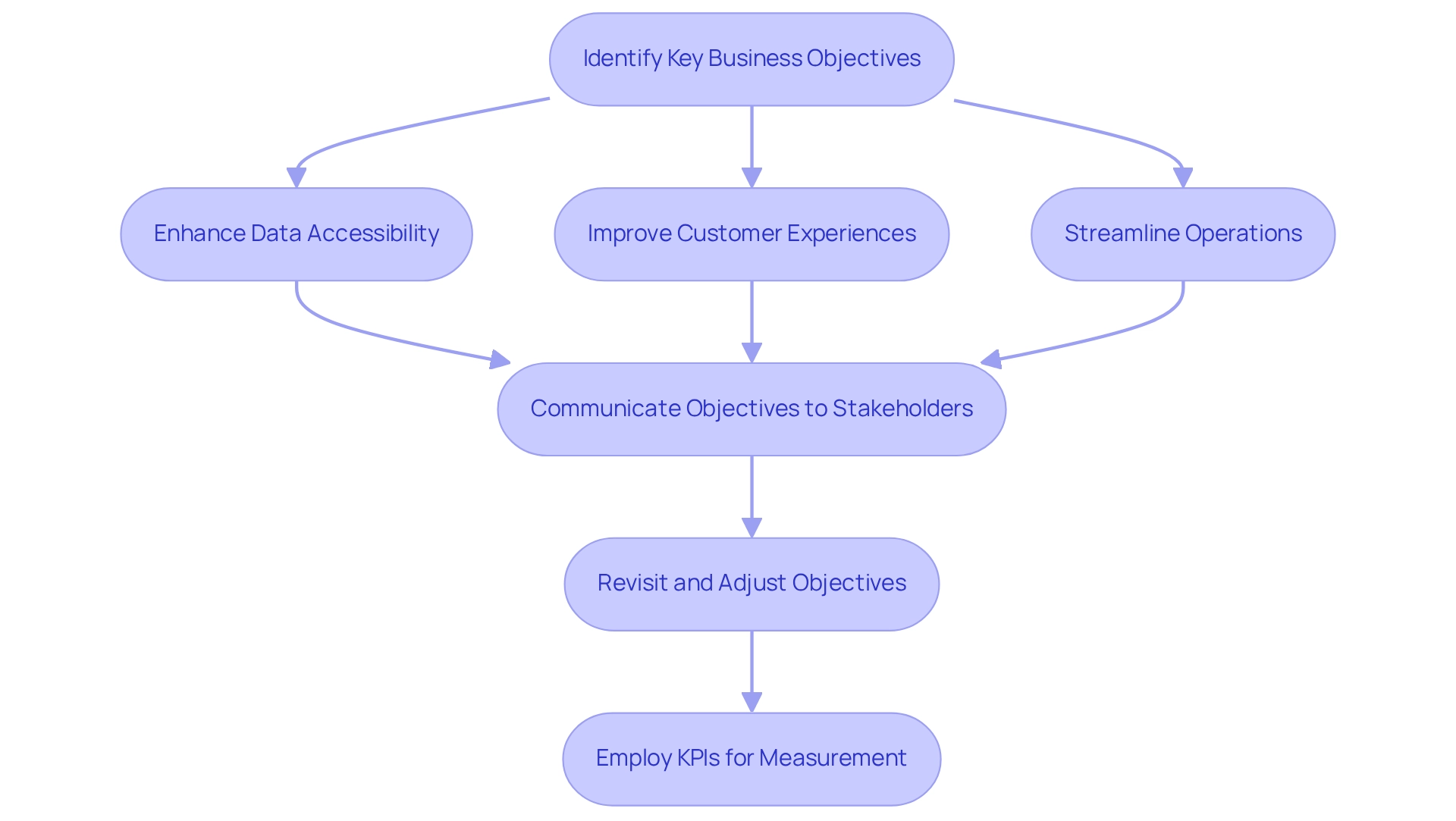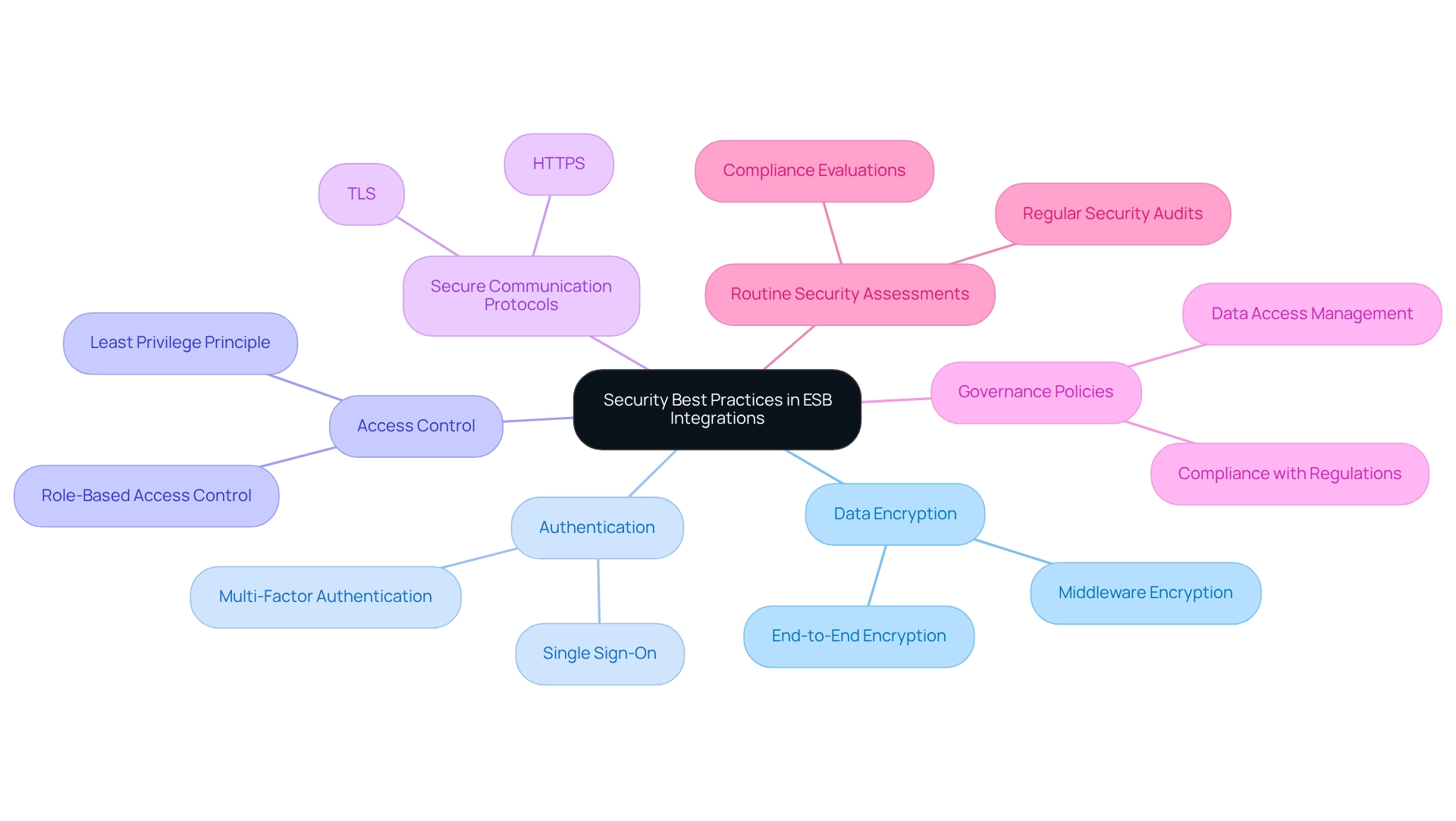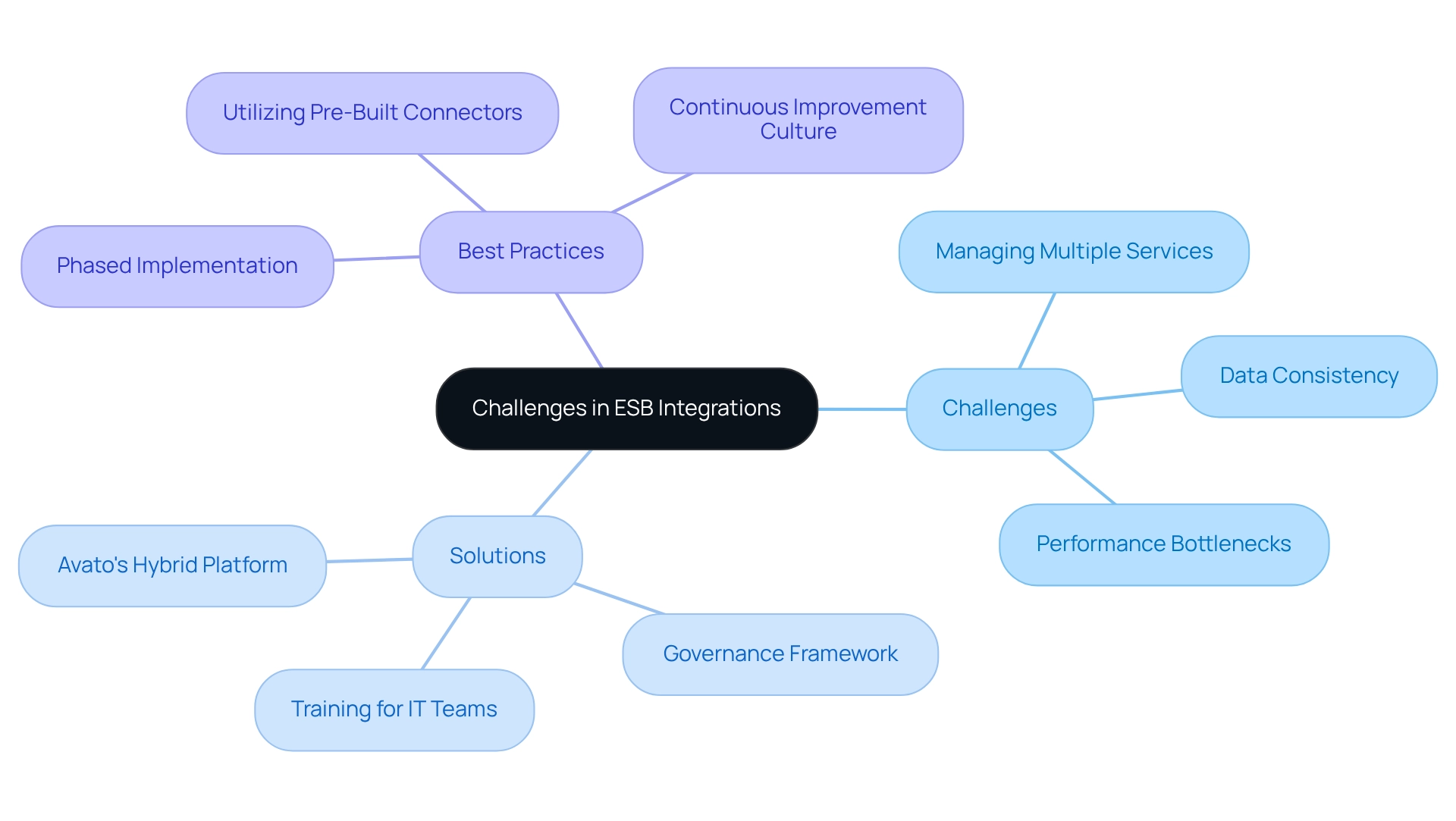Overview
This article delves into best practices for Enterprise Service Bus (ESB) integrations, highlighting strategies that significantly enhance operational efficiency and connectivity among diverse applications.
Are you facing challenges in integrating various applications within your organization? Understanding the key principles is essential.
- Clear objective-setting
- Selecting appropriate tools
- Implementing robust security measures
These foundational elements contribute to successful integration outcomes. These strategies are particularly vital for organizations transitioning to modern architectures.
By adopting these practices, you can ensure a seamless integration process that not only meets current demands but also positions your organization for future growth.
Take action now and explore how effective ESB integrations can transform your operational landscape.
Introduction
In a rapidly evolving digital landscape, organizations are increasingly turning to Enterprise Service Bus (ESB) integrations to streamline operations and enhance connectivity among diverse applications. This shift poses a critical question: how can businesses effectively manage this transition? By serving as a centralized hub for data exchange, ESBs not only promote loose coupling of systems but also enable businesses to adapt to modern technological demands, particularly as they transition from legacy systems to cloud-based solutions.
This article delves into the multifaceted world of ESB integrations, exploring essential principles and best practices for setting objectives. Furthermore, it emphasizes the importance of selecting the right tools and technologies.
Through real-world case studies and expert insights, it highlights the critical role of ESBs in driving operational efficiency and fostering innovation, while addressing the challenges organizations face along the way. As businesses embark on their digital transformation journeys, understanding the intricacies of ESB integrations becomes paramount for achieving sustainable success.
Are you ready to embrace this change and unlock the potential of your operations?
Understanding Enterprise Service Bus (ESB) Integrations
ESB integrations represent a pivotal middleware architecture that streamlines communication among diverse applications within an enterprise. Functioning as a centralized hub, it facilitates seamless data exchange between various networks, promoting loose coupling and enhancing flexibility. This separation of applications is particularly advantageous for entities aiming to integrate legacy systems with modern applications, ultimately boosting operational efficiency and agility.
To fully harness the potential of ESB integrations in integration projects, it is crucial to understand its core principles: message routing, transformation, and protocol mediation. These principles empower organizations to manage data flows effectively, ensuring that information reaches the correct destination at the right time, irrespective of the underlying technology.
Recent trends reveal a significant shift towards cloud computing, driven by its scalability, reliability, and security. Many organizations are transitioning from outdated infrastructures to cloud-based solutions, with the ESB integrations market projected to exceed USD 1.49 billion by 2034. As Vishakha Agrawal from Expert Market Research notes, “At Expert Market Research, we strive to provide you with the latest insights and trends in the market,” underscoring the growing reliance on ESB integrations as organizations prioritize digital transformation to enhance operational efficiency and customer experiences.
Real-world examples underscore the effectiveness of ESB middleware architecture across various sectors. Companies engaged in digital transformation have reported remarkable advancements in network connectivity and communication, highlighting the essential role of ESB in facilitating these changes. Successful case studies demonstrate how organizations have leveraged ESB integrations to optimize operations, reduce costs, and enhance service delivery, particularly in banking and healthcare.
Avato’s hybrid connectivity platform exemplifies how companies can maximize the value of legacy technologies while simplifying complex connections. By enabling seamless integration of various frameworks, Avato enhances data availability and responsiveness, allowing organizations to adapt swiftly to evolving market demands. Moreover, the platform provides real-time tracking and notifications on system performance, significantly reducing costs associated with implementation challenges.
The impact of ESB on operational efficiency is profound, positioning it as a cornerstone of modern enterprise architecture, especially in light of Avato’s dedication to delivering connected customer experiences. Furthermore, understanding the implications of utilizing JSON and XML for data unification is vital for effectively maximizing Avato’s hybrid connection platform.
Setting Clear Objectives for ESB Integrations
Setting clear, measurable goals for ESB integrations is not just important; it is crucial for achieving successful results. Organizations must begin by identifying the key business objectives they seek to achieve through unification. Are you looking to enhance data accessibility, improve customer experiences, or streamline operations? Research indicates that organizations with clearly defined objectives for their IT projects experience significantly higher success rates, underscoring the importance of this practice.
To ensure alignment and support from all stakeholders, these objectives must be communicated effectively throughout the unification process. Regularly revisiting and adjusting these objectives as the project progresses is essential for maintaining focus and adaptability. This iterative method enables teams to react to evolving business requirements and technological advancements, ensuring that the incorporation remains pertinent and efficient.
Optimal methods for establishing goals in projects involving ESB integrations include employing key performance indicators (KPIs) tailored to the specific needs of the organization. These KPIs should be measurable and aligned with the overall business strategy, providing a clear framework for assessing progress and success. For instance, entities that have effectively executed ESB integrations frequently report enhanced operational efficiency and reduced expenses, showcasing the tangible advantages of establishing measurable objectives.
Significantly, cloud-native deployment can facilitate the establishment of environments in minutes or even seconds, further improving operational efficiency through effective coordination.
Case studies reveal that organizations achieving substantial business results through ESB integrations often credit their success to a well-defined objective-setting process. For example, Avato’s partnership with Coast Capital illustrates how hybrid unification can streamline intricate projects, facilitating significant transitions with minimal interruptions. In June 2016, Avato enabled a crucial transition in Coast Capital’s telephone banking infrastructure with only a 63-second outage, demonstrating the speed and reliability of its solutions.
Moreover, Avato’s successful RFP victory for a prominent schedule-one Canadian bank further confirms its capabilities in the financial sector, showcasing its expertise in hybrid solutions.
Furthermore, findings from the case study titled “Future Directions for ESB Tools” suggest that ESB tools are evolving to meet the connectivity needs of big data systems, including support for both structured and unstructured data. By aligning stakeholders on unification objectives from the outset, these organizations foster teamwork and commitment, which are essential for managing the complexities of unification projects. In summary, a strategic emphasis on quantifiable goals not only increases the likelihood of successful ESB integrations but also enables organizations to adapt and thrive in a constantly changing technological landscape.

Choosing the Right Tools and Technologies for ESB
When selecting tools for ESB integrations, organizations must prioritize several critical factors, including compatibility with existing frameworks, scalability, and user-friendliness. Avato, derived from the Hungarian word for ‘dedication,’ distinguishes itself in this arena, reflecting a profound commitment to simplifying diverse frameworks and enhancing business value. Our dedicated hybrid unification platform offers a unique approach to integration, enabling businesses to secure their operations for the future.
While established ESB solutions such as MuleSoft, IBM Integration Bus, and TIBCO each possess distinct features tailored to various unification needs, Avato focuses on delivering seamless data and network connections. For example, MuleSoft is recognized for its robust API management capabilities, IBM Integration Bus excels in complex data transformations, and TIBCO is preferred for real-time data processing and extensive protocol support.
However, Avato’s platform unlocks isolated assets, empowering organizations to generate significant business value through its hybrid connectivity capabilities, backed by our team of specialists. Organizations should thoroughly assess their specific requirements, emphasizing real-time data processing and the ability to support diverse communication protocols. This tailored strategy ensures the selection of a technology stack that aligns with operational goals, particularly for Banking IT Managers who encounter unique challenges in integrating legacy systems with modern solutions.
Moreover, the adoption of ESB integrations in cloud-based solutions is on the rise, offering enhanced flexibility and substantial reductions in infrastructure costs.
Current trends indicate that nearly half of IT leaders plan to implement autonomous agents within the next two years, highlighting the growing demand for agile connectivity solutions. As entities navigate the complexities of digital transformation, leveraging effective ESB integrations becomes essential for streamlining processes and maximizing operational efficiency. Real-world examples demonstrate that organizations utilizing modern ESB technologies experience improved decision-making and compliance with regulatory requirements, underscoring the importance of selecting the right connection tools.
Additionally, utilizing Apache Camel’s open-source components and Guidewire Cloud Platform utilities can facilitate rapid development and deployment of connections, further enhancing operational capabilities. The benefits of contemporary ERP solutions, including improved business processes and increased visibility and control, further emphasize the necessity of efficient ESB integrations. Furthermore, a constructive feedback loop from users fosters ongoing improvement of the enterprise unification system, ensuring that the chosen tools remain aligned with evolving business needs.
Avato’s hybrid unification platform exemplifies these principles, equipping organizations with the necessary tools to modernize their operations while ensuring secure and reliable connectivity.
Architectural Considerations for Effective ESB Integrations
Effective ESB integrations hinge on meticulous architectural planning, which is essential for achieving seamless connectivity and operational efficiency. Key factors include ensuring loose coupling among services, facilitating independent development and deployment, thereby enhancing resilience. The implementation of a service-oriented architecture (SOA) is crucial, as it promotes interoperability and adaptability, allowing businesses to respond to evolving market demands.
Avato’s expertise in hybrid unification has transformed financial institutions by enabling swift and reliable transitions between platforms. A prime example is the successful implementation at Coast Capital, which went live in February 2013, demonstrating how Avato supports multiple interfaces with minimal downtime. Over the years, Avato has expanded its role at Coast Capital, assisting with significant system transitions, including a notable transition in June 2016, which experienced only a 63-second outage, underscoring its commitment to operational efficiency. Designing for scalability is another critical aspect; organizations must assess their deployment model—whether on-premises, cloud, or hybrid—to ensure that the architecture can support growth and maintain high availability and disaster recovery.
The shift towards microservices architecture is gaining traction, particularly with a notable increase in its application for ESB integrations. This approach not only enhances flexibility but also allows for the independent scaling of services, improving connection performance. Statistics reveal that the adoption of microservices architecture is on the rise in ESB integrations, reflecting a broader trend towards more agile and responsive connectivity solutions. Avato’s hybrid connection platform supports 12 levels of interface maturity, which is vital for enabling effective ESB integrations. As organizations increasingly recognize the importance of architectural planning for successful unification, case studies illustrate that those prioritizing these best practices are more adept at navigating the complexities of modern unification environments.
For instance, Gustavo Estrada, a client, noted Avato’s ability to streamline complex projects and deliver results within specified timelines and budget constraints. Additionally, the recent shift in cloud EAI expenditures surpassing on-premise costs highlights the growing significance of cloud-based unifying solutions, particularly relevant for banking IT managers. Looking ahead, the future of EAI will likely involve advancements in AI, IoT, and blockchain technologies, emphasizing the necessity for organizations to stay ahead of these trends.
By learning from industry experts and applying proven strategies, companies can significantly enhance their ESB implementation outcomes while minimizing risks and increasing flexibility. A phased implementation strategy is vital in this context, allowing organizations to gradually adopt new technologies while reducing potential disruptions. Furthermore, continuous monitoring and analytics are essential for optimizing system performance, ensuring that operations remain efficient and adaptable to changing requirements.
Implementing Security Best Practices in ESB Integrations
To safeguard their ESB integrations, entities must adopt a robust set of best practices, including:
- Data encryption
- Authentication
- Stringent access control measures
Implementing secure communication protocols such as HTTPS and TLS is vital for protecting data in transit; this ensures that sensitive information remains confidential and secure. Routine security assessments and compliance evaluations, as highlighted by Avato’s dedication to regulatory standards, are crucial for identifying and addressing potential risks. This proactive approach enables entities to mitigate threats before they escalate.
Establishing clear governance policies is equally important, as these policies manage data access and ensure compliance with industry regulations. Such a structured approach not only protects sensitive information but also fosters trust among stakeholders. The financial sector has faced significant challenges, with 1.7 million accounts compromised in 137 breaches in 2018 alone. This statistic underscores the necessity for rigorous security measures.
Furthermore, entities can gain insights from recent occurrences, like the increase in cyberattacks in Poland in 2024, where more than 1,000 attacks occurred weekly due to geopolitical tensions. This situation highlights the urgent need for robust defense mechanisms in the context of ESB integrations. By prioritizing security best practices, entities can effectively safeguard their collaboration processes and uphold operational integrity in an increasingly complex threat environment.
Incorporating expert opinions on security best practices further reinforces the importance of these measures. Jacob Fox, a search engine optimization manager, emphasizes, “Instead, use these statistics to help receive buy-in from executives and team members trying to understand how investing in security pays dividends.” Cybersecurity experts stress that investing in security not only protects data but also delivers long-term dividends by enhancing organizational resilience.
By ensuring data encryption in middleware and implementing comprehensive security strategies, entities can navigate the complexities of ESB integrations while safeguarding their critical assets. Avato’s dependable and forward-looking technology framework aligns with these best practices, offering a strong basis for secure connections and enabling businesses to future-proof their operations through seamless data and network collaboration.

Monitoring and Performance Management for ESB Integrations
To ensure optimal performance of ESB connections, firms must adopt robust monitoring solutions that track critical metrics. Establishing key performance indicators (KPIs) such as message throughput, latency, and error rates is vital for assessing system health. Real-time monitoring tools play a crucial role in this process, offering immediate insights and alerts that empower teams to swiftly address performance issues as they arise.
Regular performance evaluations, including load testing and capacity planning, are essential to adapt the ESB to changing business demands. For instance, entities that implement thorough monitoring strategies report notable advancements in system health and operational efficiency. According to industry standards, effective monitoring can lead to a reduction in incident response times by up to 30%, underscoring the value of proactive performance management.
Furthermore, COBIT 4.1 advises measuring the percentage of incidents that require local support, providing a quantitative measure of monitoring effectiveness.
Expert recommendations suggest that organizations should not only focus on traditional metrics but also consider the alignment of their KPIs with overall business objectives. This comprehensive approach guarantees that monitoring efforts support strategic objectives, thereby improving the overall efficiency of ESB integrations. Incorporating a RACI framework can further structure the monitoring activities related to incident logging and resolution, ensuring accountability and clarity in performance management.
By leveraging advanced monitoring solutions, businesses can maintain a competitive edge through their ESB integrations, ensuring that these systems are resilient and responsive to evolving market needs. As Gustavo Estrada noted, ‘Avato has the capability to streamline intricate projects and provide outcomes within preferred timelines and financial limits,’ highlighting how Avato’s hybrid connection platform distinctly aids these monitoring strategies. Since its founding in 2010, Avato has demonstrated its effectiveness in financial institutions, such as the successful implementation at Coast Capital, where monitoring strategies have transformed operations, leading to cost reduction, faster product delivery, and improved customer satisfaction.

Continuous Improvement and Feedback in ESB Integrations
Creating robust feedback systems is essential for the continuous improvement of ESB integrations. Organizations must actively solicit input from stakeholders, including end-users and IT teams, to identify enhancement opportunities. By embracing agile methodologies, teams can engage in iterative development, facilitating rapid adjustments based on real-time feedback.
This strategy not only cultivates a culture of responsiveness but also optimizes the overall integration process. Furthermore, conducting post-implementation reviews is critical for gaining insights into the effectiveness of the integration. These evaluations can reveal vital information that guides future projects, ensuring that the ESB adapts to the evolving requirements of the organization. Statistics indicate that organizations employing feedback mechanisms in IT projects experience a significant increase in project success rates, alongside improvements in stakeholder satisfaction and operational efficiency.
For instance, participants engaged in a structured feedback process dedicated:
- 15 minutes to reviewing personnel files
- 5 minutes to pre-discussion surveys
- 20 minutes to feedback discussions
This underscores the importance of a systematic approach.
A case study on the ongoing enhancement of ESB integrations highlighted how organizations that implemented feedback loops significantly improved their connection processes. Experts assert that feedback is not merely a formality but a strategic tool that propels innovation and efficiency in ESB integration projects. Gustavo Estrada, Acting Provincial Director at BC Provincial Health Services Authority, noted Avato’s ability to simplify complex projects and achieve results within defined timeframes and budget constraints, illustrating the tangible benefits of effective unification strategies.
Moreover, Avato’s hybrid unification platform plays a crucial role in this process by providing real-time monitoring and performance notifications, which substantially reduce costs and enhance operational visibility. The emerging trend of utilizing generative AI to refine performance evaluations underscores the modern tools available to bolster feedback systems in ESB connections. Assessing the current performance culture and the efficacy of existing frameworks is essential for organizations aiming to elevate their performance management initiatives.
By prioritizing feedback and agile methodologies, organizations can ensure their ESB integrations align with business objectives and remain adaptable to changing needs. This ultimately empowers them to protect their operations through seamless data and framework connectivity.
Navigating Challenges in ESB Integrations
Organizations frequently face significant obstacles during ESB connections, such as managing multiple services, ensuring data consistency, and addressing performance bottlenecks. Avato’s dedicated hybrid unification platform is specifically designed to simplify these challenges, empowering businesses to enhance their operations through seamless data and system connections. A staged execution method is essential; it allows for gradual incorporation and thorough testing, significantly reducing risks associated with large-scale modifications.
Creating a robust governance framework is vital for managing service dependencies and ensuring adherence to data standards, which can facilitate the merging process. Notably, only half (52%) of lines of business express confidence in iPaaS users to establish connections, underscoring the need for reliable connection services such as those offered by Avato.
Investing resources in training and support for IT teams is another critical factor that enhances their capability to efficiently manage and optimize ESB integrations. This investment not only equips teams to tackle connectivity challenges but also fosters a culture of continuous improvement. For instance, organizations that implement phased strategies often report a 30% increase in project success rates, demonstrating the effectiveness of this approach in IT projects.
Moreover, industry leaders stress the importance of managing complexity within enterprise service buses. As Roopali Joshi, COO, observes, effective management is crucial for navigating these challenges. By leveraging pre-built connectors, as showcased in Avato’s hybrid connection platform, organizations can streamline the integration process and conserve valuable development time.
This strategy not only accelerates deployment but also minimizes the risk of errors, ensuring a smoother transition to integrated systems. A case study on the Library of Pre-Built Connectors illustrates how these solutions can significantly enhance efficiency in connection efforts.
In summary, addressing common challenges in ESB connections requires a strategic focus on phased implementation, governance, and team empowerment. By adopting these best practices and utilizing Avato’s dedicated hybrid connection platform, organizations can more effectively navigate the complexities of ESB integrations, leading to successful outcomes. The emphasis on reliable, secure, and efficient integration services further reinforces the importance of these strategies.

Conclusion
Embracing Enterprise Service Bus (ESB) integrations is not merely a step; it is a strategic imperative for organizations seeking to enhance operational efficiency and drive innovation within a rapidly evolving digital landscape. By grasping the fundamental principles of ESBs—such as message routing and protocol mediation—businesses can effectively manage data flows and improve connectivity among diverse applications. The shift from legacy systems to cloud-based solutions transcends trends; it is essential for organizations that aspire to remain competitive and responsive to market demands.
Establishing clear objectives for ESB integrations is pivotal to ensuring successful outcomes. Organizations that articulate measurable goals are more likely to realize significant enhancements in operational efficiency and customer experiences. Moreover, selecting the appropriate tools and technologies tailored to specific needs is crucial for maximizing the advantages of ESB solutions. By assessing compatibility, scalability, and user-friendliness, organizations can future-proof their operations and streamline complex integrations.
Architectural considerations are equally vital, as they form the bedrock of effective ESB implementations. Prioritizing loose coupling, service-oriented architecture, and scalability ensures resilience and adaptability. Furthermore, implementing robust security measures and continuous monitoring is essential for protecting data and maintaining optimal performance throughout the integration process.
Ultimately, the journey of integrating ESBs demands a commitment to continuous improvement and collaboration among stakeholders. By harnessing feedback mechanisms and agile methodologies, organizations can refine their integration processes, leading to enhanced performance and alignment with business objectives. As organizations navigate the complexities of ESB integrations, adherence to best practices and strategic planning will significantly bolster their success in achieving sustainable growth and operational excellence.

